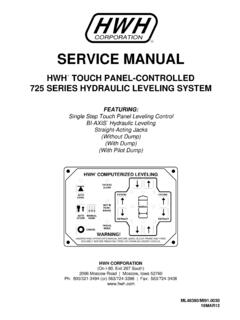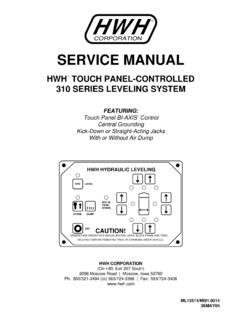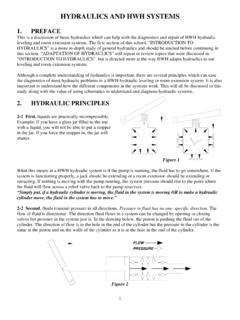Transcription of CHAPTER 5 - GLOSSARY of HYDRAULIC TERMS - …
1 C:\1_TechSchool\ | Revised: 04 SEP15 | Page 1 of 2 HWH Online Technical School Lesson 1: Introduction to Hydraulics CHAPTER 5 " GLOSSARY of HYDRAULIC TERMS " (Filename: | Revised: 04 SEP15) Click Here for Printable PDF File CHAPTER 5 - GLOSSARY of HYDRAULIC TERMS Accumulator: A device for storing HYDRAULIC energy. Actuator: A device that converts HYDRAULIC energy into mechanical energy. ( , cylinders, motors.) Aeration: Air in the fluid. Cant: The leaning or tilt of an object, especially sideways. Cavitation: Air bubbles or pockets created in HYDRAULIC lines and components by the turbulent flow of HYDRAULIC fluid.
2 Cylinder: An actuator that converts HYDRAULIC energy into linear or rotary mechanical energy. (NOTE: Rotary cylinders usually rotate less than one full revolution.) Displacement: The volume of fluid that is transferred from the pump inlet to the outlet during one revolution of the pump. Displacement is expressed in cubic inches per revolution. Energy: The capacity for doing work. Filter: A device that removes contaminants from the HYDRAULIC fluid and is rated in microns. Flash Point: The lowest temperature at which vapors from a volatile liquid will ignite.
3 Force: A push or pull that is exerted on an object in order to change its position or direction of movement. Fluidity: Fluidity is the ability of the fluid to take the shape of the container it is in. Horsepower: 1 Horsepower = 33,000 foot-pounds/one minute or 1 Horsepower = 550 foot-pounds/one second Hydraulics: The study of fluids in motion or at rest. Hydrodynamics: Devices or systems that use the impact or kinetic energy in the liquid to transmit power. Hydrostatics: Devices or systems that use force applied to a confined fluid.
4 Pressure is distributed over the area exposed to the fluid and is expressed in force per unit area (PSI). Incompressible Fluid: A fluid which is not reduced in volume by an increase in pressure. Laminar Flow (Streamline): The smooth and efficient flow of HYDRAULIC fluid through HYDRAULIC lines and components. Line: A tube, pipe or hose for conducting a fluid. Liquid: A fluid that is relatively incompressible. (NOTE: A gas is a fluid which is very compressible). Mass: Represents the amount of matter in an object, and its inertia or resistance to movement.
5 C:\1_TechSchool\ | Revised: 04 SEP15 | Page 2 of 2 Micron: A measure of size equal to one millionth of a meter, or approximately inch. Micron size is often used to describe the size of particles that a filter will remove from the fluid. For example, a 20 micron absolute filter is said to remove all particles greater than 20 microns. Motor: An actuator that converts HYDRAULIC energy into rotary mechanical energy. Non-positive displacement pump: A pump in which the inlet and outlet are hydraulically connected, so that the fluid can re-circulate in the pump when pressure builds.
6 Pascals law: Pressure in an enclosed container is transmitted equally and undiminished to all parts of the container and acts at right angles to the enclosing walls. Positive displacement pump: A pump that has the inlet sealed from the outlet. Power: An amount of work (foot-pounds) done in a given amount of time (seconds or minutes). Pressure The force exerted over a surface divided by its area. Pump A device that creates the flow of HYDRAULIC fluid. (NOTE: A pump converts mechanical energy into HYDRAULIC energy.) Radial piston pump: Where the pistons are set perpendicular to the pump s center, like sun rays.
7 Reciprocating motion: The movement of HYDRAULIC fluid back and forth in cylinder bores through the use of pistons. Reservoir: A container for keeping a supply of working fluid in a HYDRAULIC system. Specific gravity: The density or mass of a liquid. The specific gravity (SG) of a liquid is also its weight as compared to the weight of water in the same amount and at the same temperature. Thermal expansion: The dimensional changes in increased volume exhibited by solids, liquids, and gases for changes in temperature while pressure is held constant.
8 Valve: A device that controls either pressure of fluid, direction of fluid flow, or rate of flow. Viscosity: A measure of the fluid s resistance to flow. Weight: A result of the gravitational force or pull on the object. Work: Takes place when a force (in pounds) is moved through a distance (in feet).










